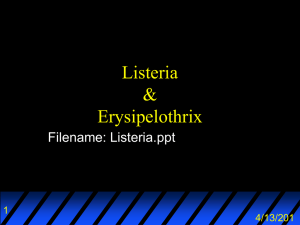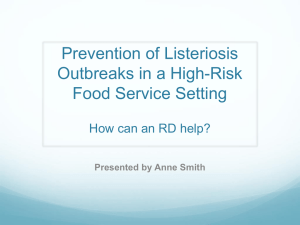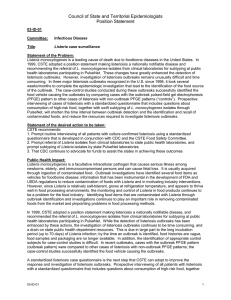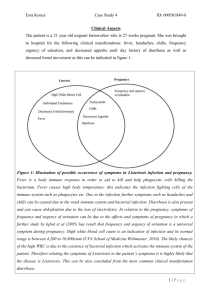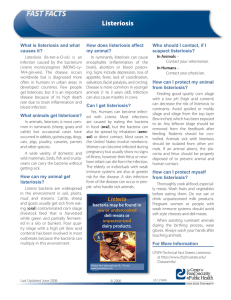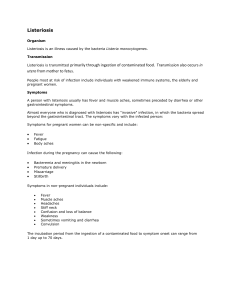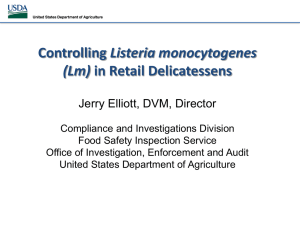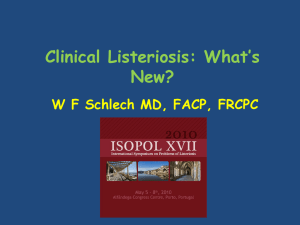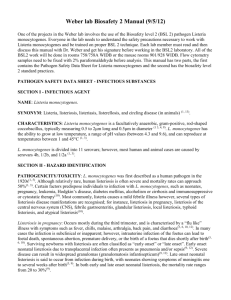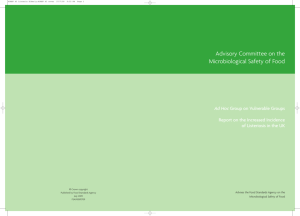Listeria Monocytogenes - Home
advertisement
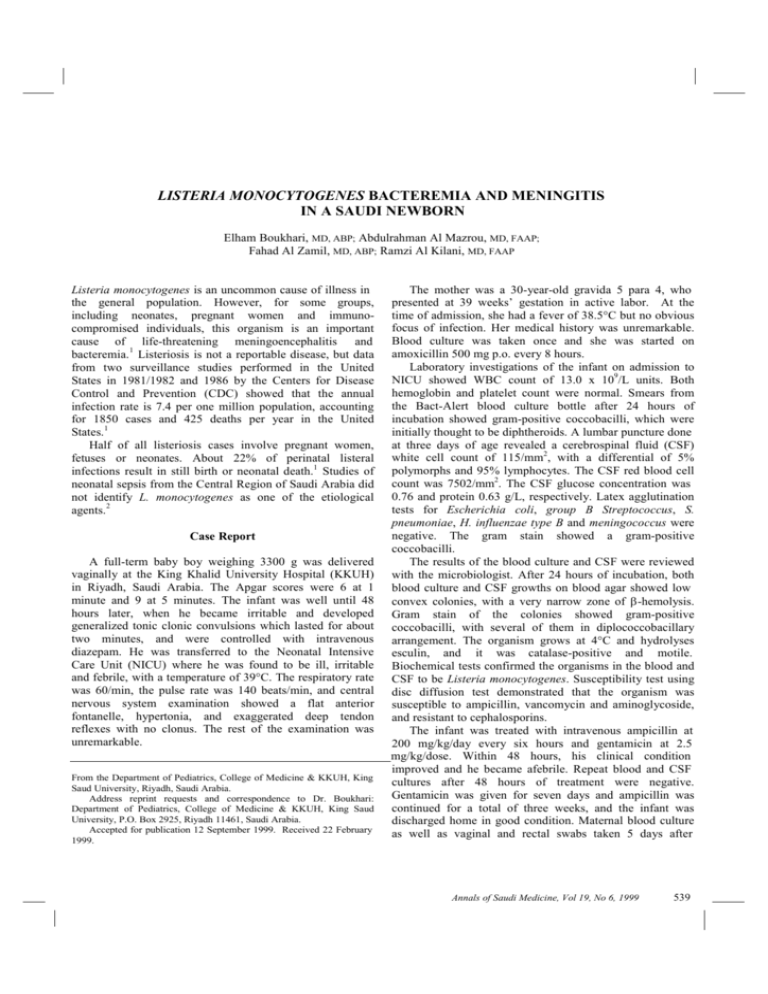
LISTERIA MONOCYTOGENES BACTEREMIA AND MENINGITIS IN A SAUDI NEWBORN Elham Boukhari, MD, ABP; Abdulrahman Al Mazrou, MD, FAAP; Fahad Al Zamil, MD, ABP; Ramzi Al Kilani, MD, FAAP Listeria monocytogenes is an uncommon cause of illness in the general population. However, for some groups, including neonates, pregnant women and immunocompromised individuals, this organism is an important cause of life-threatening meningoencephalitis and bacteremia.1 Listeriosis is not a reportable disease, but data from two surveillance studies performed in the United States in 1981/1982 and 1986 by the Centers for Disease Control and Prevention (CDC) showed that the annual infection rate is 7.4 per one million population, accounting for 1850 cases and 425 deaths per year in the United States.1 Half of all listeriosis cases involve pregnant women, fetuses or neonates. About 22% of perinatal listeral infections result in still birth or neonatal death.1 Studies of neonatal sepsis from the Central Region of Saudi Arabia did not identify L. monocytogenes as one of the etiological agents.2 Case Report A full-term baby boy weighing 3300 g was delivered vaginally at the King Khalid University Hospital (KKUH) in Riyadh, Saudi Arabia. The Apgar scores were 6 at 1 minute and 9 at 5 minutes. The infant was well until 48 hours later, when he became irritable and developed generalized tonic clonic convulsions which lasted for about two minutes, and were controlled with intravenous diazepam. He was transferred to the Neonatal Intensive Care Unit (NICU) where he was found to be ill, irritable and febrile, with a temperature of 39°C. The respiratory rate was 60/min, the pulse rate was 140 beats/min, and central nervous system examination showed a flat anterior fontanelle, hypertonia, and exaggerated deep tendon reflexes with no clonus. The rest of the examination was unremarkable. From the Department of Pediatrics, College of Medicine & KKUH, King Saud University, Riyadh, Saudi Arabia. Address reprint requests and correspondence to Dr. Boukhari: Department of Pediatrics, College of Medicine & KKUH, King Saud University, P.O. Box 2925, Riyadh 11461, Saudi Arabia. Accepted for publication 12 September 1999. Received 22 February 1999. The mother was a 30-year-old gravida 5 para 4, who presented at 39 weeks’ gestation in active labor. At the time of admission, she had a fever of 38.5°C but no obvious focus of infection. Her medical history was unremarkable. Blood culture was taken once and she was started on amoxicillin 500 mg p.o. every 8 hours. Laboratory investigations of the infant on admission to NICU showed WBC count of 13.0 x 109/L units. Both hemoglobin and platelet count were normal. Smears from the Bact-Alert blood culture bottle after 24 hours of incubation showed gram-positive coccobacilli, which were initially thought to be diphtheroids. A lumbar puncture done at three days of age revealed a cerebrospinal fluid (CSF) white cell count of 115/mm2, with a differential of 5% polymorphs and 95% lymphocytes. The CSF red blood cell count was 7502/mm2. The CSF glucose concentration was 0.76 and protein 0.63 g/L, respectively. Latex agglutination tests for Escherichia coli, group B Streptococcus, S. pneumoniae, H. influenzae type B and meningococcus were negative. The gram stain showed a gram-positive coccobacilli. The results of the blood culture and CSF were reviewed with the microbiologist. After 24 hours of incubation, both blood culture and CSF growths on blood agar showed low convex colonies, with a very narrow zone of -hemolysis. Gram stain of the colonies showed gram-positive coccobacilli, with several of them in diplococcobacillary arrangement. The organism grows at 4°C and hydrolyses esculin, and it was catalase-positive and motile. Biochemical tests confirmed the organisms in the blood and CSF to be Listeria monocytogenes. Susceptibility test using disc diffusion test demonstrated that the organism was susceptible to ampicillin, vancomycin and aminoglycoside, and resistant to cephalosporins. The infant was treated with intravenous ampicillin at 200 mg/kg/day every six hours and gentamicin at 2.5 mg/kg/dose. Within 48 hours, his clinical condition improved and he became afebrile. Repeat blood and CSF cultures after 48 hours of treatment were negative. Gentamicin was given for seven days and ampicillin was continued for a total of three weeks, and the infant was discharged home in good condition. Maternal blood culture as well as vaginal and rectal swabs taken 5 days after Annals of Saudi Medicine, Vol 19, No 6, 1999 539 BOUKHARI ET AL delivery were negative. Direct questioning regarding potential sources of listeria, such as soft cheese, unpasteurized milk and undercooked meats for the mother was unrevealing. Discussion Listeria monocytogenes is a gram-positive bacillus that grows readily on blood agar, producing -hemolysis.1 The organism is commonly found in the environment, particularly in the soil, in decaying vegetation, and as part of the fecal flora of many animals and poultry. It can give rise to various infections, ranging from asymptomatic carriage or a mild influenza-like illness to fatal septicemia and meningoencephalitis.3 The rate of infection is highest among infants of less than one month and adults over 60 years of age. There is a considerable morbidity and mortality associated with listeriosis, with a 20%-50% mortality in perinatal disease.2-4 The infection in adults most likely begins after ingestion of contaminated food. The organism has been recovered from several domestic as well as imported food products which have been linked to major epidemics. However, most cases of listeriosis in pregnant women are of a sporadic nature, and the source of infection is usually unknown.5 Listeria may infect the fetus through the infected birth canal or transplacentally. There are two clinical forms of neonatal listeriosis, early onset and late onset. Early onset disease usually manifests within the first five days of life as septicemia, especially in preterm infants of symptomatic mothers. Late onset disease occurs 1 to 4 weeks after delivery, and usually presents in the neonate as a purulent meningitis.5 The mother is commonly asymptomatic. Our case represents an early onset disease with meningitis and septicemia. Such a presentation, however, is not unusual, as some authors have reported the occurrence of meningitis in as many as 24% of infants with early onset disease.5-7 Listeria is susceptible to penicillin, erythromycin, ampicillin, chloramphenicol, tetracycline and rifampin, but resistant to cephalosporins. It is possible that the mother’s fever during labor was due to listeria infection. The maternal blood culture may be 540 Annals of Saudi Medicine, Vol 19, No 6, 1999 negative for listeria, and it has been found in one study that only 44% of mothers have positive cultures and that there is a poor correlation between positive maternal cultures and positive fetal blood cultures.4,6,7 In clinical specimens, as the result of morphologic similarity to diphtheroids and streptococci, laboratory misidentification of L. monocytogenes isolates as diphtheroids is not uncommon, and so the isolation of a diphtheroid from blood or CSF should always alert the clinician to the possibility that the organism is really L. monocytogenes.8 In contrast to other countries, listeriosis is not frequently reported in Saudi Arabia.9 This may be related to misidentification of such organisms, as happened in our case, coupled with a low index of suspicion, as well as poor communication between clinicians and microbiologists. This is the first reported case of early onset listeria septicemia associated with meningitis in a full-term neonate in the Riyadh region. It represents one of the possible clinical scenarios seen in perinatal listeriosis, an uncommon, perhaps underdiagnosed and, therefore, often overlooked cause of perinatal infection. References 1. 2. Lorber B. Listeriosis. Clin Infect Dis 1997;24:1-11. Haque KN. Half a decade of neonatal sepsis. J Trop Pediatr 1990;36: 20-3. 3. Pejaver RK, Watson AH, Mucklow ES. Neonatal cross infection with listeria monocytogenes: case reports. J Infect 1993;26:301-3. 4. Boucher M, Yonekura ML. Perinatal listeriosis (early onset): correlation of antenatal manifestations and neonatal outcome. Obstet Gynecol 1996;68:593-7. 5. Ried FX, Pinner RW, de Lourdes Tosca M, et al. A point-source food borne listeriosis outbreak: documented incubation period and possible mild illness. J Infect Dis 1994;170:693-6. 6. McLauchlin J. Human listeriosis in Britain, 1967-85: a summary of 722 cases. Epidemiol Infect 1990;104:191-201. 7. Grieg A, Roth P. Colony stimulating factor 1 in the human response to neonatal listeriosis. Infect Immunol 1995;63:1595-7. 8. Gellin BG, Broome CV. Listeriosis. JAMA 1989;261:1313-20. 9. Mohammed CK. Listeriosis. ARAMCO Epidemiol Bull 1983;21:14. 10. Schlech WF. Listeriosis: epidemiology, virulence and significance of contaminated food stuffs. J Hosp Infect 1991;19:211-24.
